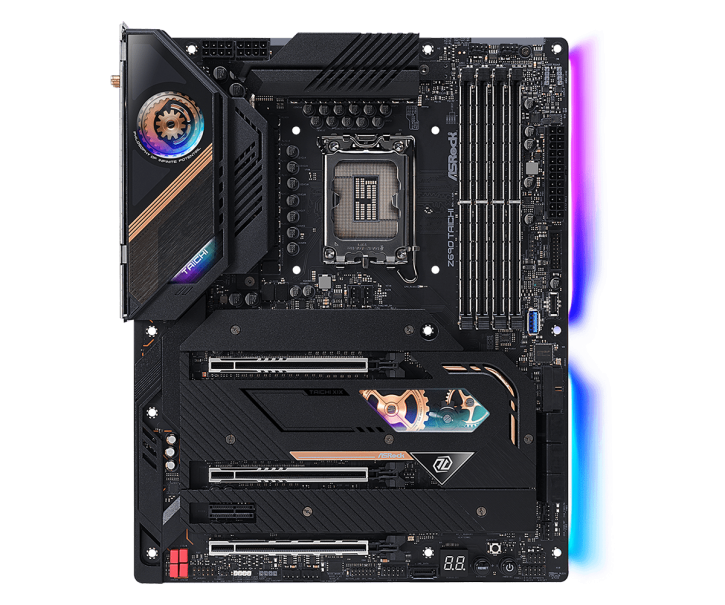Introduction
ASRock Z690 Taichi review
Would some Taichi help defend the pricing this time?
Meet the ASRock Z690 Taichi motherboard. This product is from a series that already appeared using the Z590 chipset, which we’ve reviewed not long ago. When looking at the overall specs, the ASRock Z690 Taichi isn’t much different from the predecessor, which would explain such a price difference. We can see the (not wanted) progress (?) in the prices as the new one is even more expensive, as the MSRP is 589.99 USD (that’s 130 USD more than Z590). For 629 USD, you can find the MSI Z690 Unify, and for about 600 USD, there’s an Asus Maximus Z690 Hero available. There are, of course, cheaper ASRock Z690 models like PG Velocita, Steel Legend (DDR4), so you should find your match. But coming back to the Asrock Z690 Taichi – it uses an (almost all) black design on an all-black PCB. There are cog/gear accents visible again (with some new gold elements). It does still look good, we admit.
This is a 30.5 x 24.4 cm product, and that’s typical of the ATX form factor. It’s equipped with the Z690 chipset, and it offers such features as a 20-phase power design, 2.5 Gigabit Ethernet, two Thunderbolt ports (40 Gbps), and a built-in Wi-Fi module. As for features that would make it stand out from the crowd of other Z690 products (from other manufacturers), well, that would probably be just the design with cogs/gear and the Thunderbolt ports. On the other side – you can see only six USB Type-A ports and three M.2 slots; both numbers don’t look impressive. The ASRock Z690 Taichi includes three full-length PCIe slots. The top two slots support PCIe 5.0 x16 and x8/x8; the third slot is PCIe 4.0 x16 (x4 mode). You can find one Ethernet controller on this board: a Realtek Killer E3100G with 2.5 Gbe support. The wireless connection has Killer AX1675x Wi-Fi, a 802.11ax Wi-Fi 6E Module and supports IEEE 802.11a/b/g/n/ax.There are three M.2 Sockets for your SSDs: two of them support PCIe Gen4 x4, and one is PCIe Gen3 x2 (so not even Gen3 x4). You also get seven SATA ports. As for the audio, you get the Realtek® ALC1220 codec with ESS SABRE9218 DAC for Front Panel Audio (130dB SNR). The power section is really good, as it’s a 20-phase design that should help handle even the most demanding CPUs, such as the Core i9 12900K or the i7 12700K. Premium 105A Power Chokes aid it with the help of premium memory alloy choke (Reduces 70% core loss compared to iron power choke) and Nichicon 12K black caps (100% Japan-made high-quality conductive polymer capacitors).
Four memory slots support up to 128 GB total DDR5-6400. There is some good information for RGB fans: one regular (12V) RGB LED header and three addressable (5V) RGB LED headers. Onboard power and reset buttons are located in the bottom-right; a two-digit LED debugger sits on the left side. Lighting can be synchronized using the ASRock Polychrome SYNCsoftware. So what does Z690 mean in reality?
DDR5 and PCIe Express 5.0 are among the first-ever for Intel products. Z690 is the enthusiast chipset from Intel, and this motherboard is powered by it. It also marks the dawn of a new era; Intel’s Alder lake processors are a completely new and faster architecture. Alder Lake puts the company fully back in the multi-core ring, led by its squad of sixteen-core goliaths built on Intel’s transistor-dense 10-nanometer manufacturing process. But this time, Intel delivers its interpretation of the term BIG.little. The new processors will have energy and performance cores to balance power consumption in idle and load conditions. The new P- and E-core design places more demands on the operating system to delegate duties more dynamically, necessitating the development of a motherboard power supply circuit that can react quickly to changes in load. You can see the 20-phase power design in the Asrock, which should help real life. We’ll check this Z690 motherboard with a Core i9 1290K and take it through our benchmark paces for this review. The board, as stated, is positioned in the high-end segment of a market, and it looks attractive. Let’s have a closer look at it then, right?




